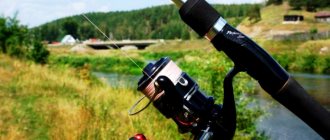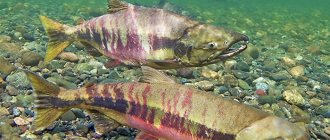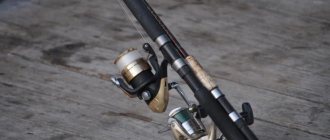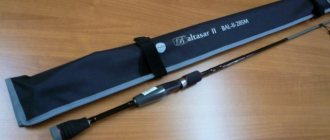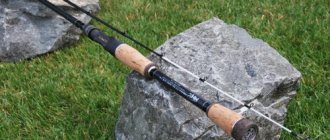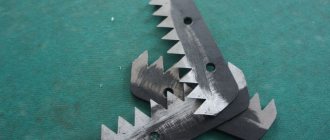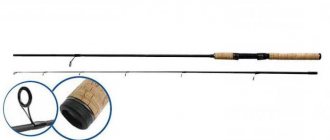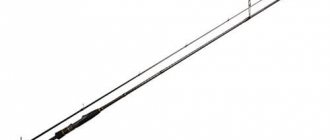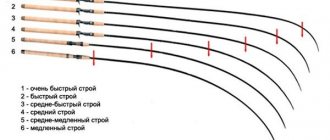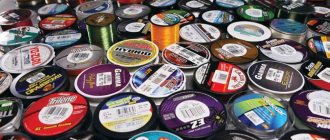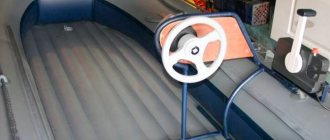The best telescopic spinning rod is the rod most suitable for solving the tasks at hand, catching certain types of predators, using specific fishing methods and artificial baits. A thoughtful approach and taking into account all the features of fishing will allow you to choose the telescopic spinning rod that is most suitable and meets all your needs.
Most modern fishermen use plug rods. They are more common and come in a huge range. However, a good telescopic spinning rod has never hurt anyone. It will come in handy in the following situations:
- For business trips and travel.
- For hiking trips and long hiking trips to the pond.
- For those who rarely engage in spinning fishing and do not have the opportunity to keep a large amount of gear at home, in particular plug rods.
In general, telescopic spinning rods are relevant in situations where the length of the fishing rod is of fundamental importance. The more compact the “stick”, the better.
Material selection
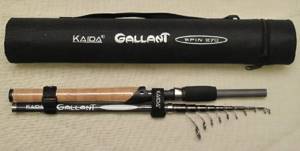
The materials for making fishing rods are usually:
- fiberglass
- composite materials
- carbon fiber
The cheapest models are made from fiberglass. They show good rigidity, but their strength is often insufficient and their weight is too high. This is why fiberglass rods are commonly used for feeders.
Composite fishing rods are made from fiberglass, to which carbon components are added for strength.
Carbon fiber rods are highly durable and sensitive, which is why they have become more widespread. But at the same time, they are the most fragile, so they require careful treatment.
Choosing a telescopic spinning rod
In order to choose the right spinning rod of this type, you should take into account a number of fishing conditions, the weight of the bait used, the size of the fish and the type of fishing.
Size of the reservoir and presence of current:
- On small rivers, streams, small ponds or oxbow lakes with shallow depths, where there is no need to use heavy baits and make long casts, rods with a length of no more than 2.1 meters and a weight of up to 15 grams are suitable.
- For medium-sized reservoirs, sticks with a length of 2.4 to 2.7 meters with a dough of 15 to 30 grams are more relevant.
- Long heavy-class rods with a length of 3.0-3.0 meters and a test weight of more than 30 grams are used for fishing at great depths in large deep rivers, large reservoirs, and flowing lakes.
Type of fish:
- To catch small predators weighing up to 1 kg (perch, grass pike), use short rods of the light or ultralight classes with a length of up to 2.1 meters and a weight of up to 15 grams.
- For medium-sized pike, pike perch, and asp weighing up to 2-3 kg, light and medium class spinning rods with a length of up to 2.7 meters and a dough weight of up to 30 grams are used.
- The large trophy predator is caught from great depths with heavy-class rods up to 3.0 meters long and weight over 30 grams.
Recommended reading: How to make a fishing rod stand with your own hands
Wiring type:
- For uniform placement of various spinners, fast and medium action rods are used.
- For jigging, fast action spinning rods are used.
- When fishing with twitching baits, rigid rods with fast or ultra-fast action are best suited to perform a full jerk retrieve.
Depending on the system

The structure of a fishing rod shows the degree of its flexibility and elasticity. According to different classifications, the tuning can be fast, medium and slow, or differ in types: A, B, C and D.
If a rod has a fast action, this means that only the very tip bends, while a rod with a slow action can bend from the very handle. In the letter classification, type A is the fastest and type D is the slowest.
The presence of docking joints on a telescopic rod imposes strong restrictions on the choice of action. It is quite difficult to provide the necessary level of flexibility to the connecting nodes, so the vast majority of these spinning rods have a fast action - only the very last link is sensitive.
Criterias of choice
There is no doubt that when choosing fishing equipment, you should give preference to purchasing with a known quality, and this is guaranteed by a product from a well-known brand, purchased from a reliable retail outlet. The choice of telescopic spinning rod begins with an inspection of the knee joints, the number of which can vary from three to nine elements. Having spread the rod to its full length, check the blank for rigidity by shaking the spinning rod. In a reliable thing, there are no backlashes and inaudible extraneous sounds. The form should not be noodles. If the quality of the tool is normal, the angler will feel the tension of the tackle without any failures in movement.
Important! It is worth paying attention to the accuracy of fitting the rings, which should not move when unfolding, touch each other and bend when folding the gear.
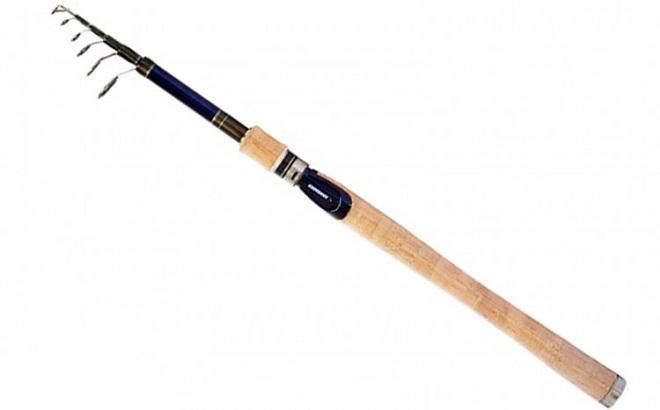
It is preferable to choose a spinning rod with a cork handle and a reel seat made of a light metal alloy, which can at least somehow affect the reduction in weight of the equipment. Having completed the visual inspection and making sure that there are no visible defects, they determine the operating parameters of the spinning rod, selecting the version suitable for the expected fishing conditions. In this direction, the fisherman should highlight the criteria for determining the optimal length of the tackle, the material used to make the rod blank, its structure and test parameters. These values depend on the type of bait used, the type of reservoir being fished and the structure of the coastline, which affects casting, the intensity and methodology of the fishing method. It is on these selection parameters that we will dwell in more detail in the continuation of the article, pointing out to the angler the possible options for choosing.
Material of manufacture
Telescopic spinning rods, like many other fishing equipment, are made from composite plastic materials that differ in the variants of binding components represented by different types of polymers. The most widely used materials for making fishing rods are fiberglass, carbon fiber, also known as carbon, and composite. Fiberglass telescopes are considered reliable and non-fragile, resistant to dynamic loads and at the same time flexible. But the big disadvantage of fiberglass is its weight. Telescopic spinning rods made of fiberglass are heavy and quickly tire the angler’s hand. Although, their so-called oakiness helps in the fight against powerful fish and has a positive effect on casting distance.
Carbon fiber tackle is much lighter than fiberglass, more sensitive and has better balance, but is fragile. Such tackle requires careful care of the form. After all, sand that gets on the fishing rod and, as a result of folding the telescope, scratches the surface of the material, renders the fishing rod unusable. The price of carbon fiber telescopes is high. The best option is to purchase a composite spinning rod, which, in terms of material properties, is intermediate between the examples presented above. It is reliable, undemanding to operating conditions, and the cost is in the rank of budget gear.
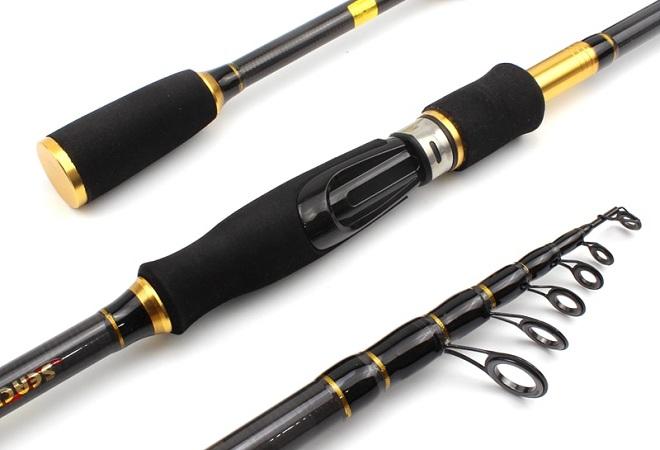
Test values
The test values of the telescopic stick are chosen based on what baits the angler most often intends to use during fishing. It’s worth mentioning right away that you’re unlikely to find this type of gear in ultralight, but in the range of medium and heavy class versions of telescopic spinning rods, there’s more than enough. These are the ones you should focus on when planning to purchase tackle of this design.
Typically, telescopes are labeled with test values in grams, ounces or pounds. The range indicated on the form will indicate the optimal weight of the baits used for fishing, which should not be neglected, especially when going beyond the upper limits, to avoid overloading the gear, which is already sensitive to loads due to the large number of joints. In the middle class, the optimal range is 10–30 grams. It is more rational to buy a more powerful rod with 20-50 grams. Such values cover a significant mass of baits suitable for catching freshwater predators.
Length

The length of a spinning telescope should be selected based on the conditions of the planned fishing. Such conditions include where the angler will cast the bait from. For example, shore fishing is significantly different from fishing done from a boat. In turn, coastal fishing may also have differences. Coastal fishing conditions vary depending on the structure and presence of thickets in the coastal zone from which casts are made. If the clean shore comes close to the water area of the reservoir without the presence of coastal and coastal thickets of reeds, bushes and trees with a crown hanging over the water, then for long-range spinning rods with the longest blank are selected. Under such conditions there are no obstacles to the swing. If there is a tree crown nearby or close to suitable bushes and reeds, throwing the bait with long tackle is inconvenient and risks the bait getting caught on obstacles.
Fishing from a boat is limited by the space of the vessel, and range fades into the background, due to the fact that you can swim close to a promising point. Therefore, for cramped conditions, hunting from a boat and inconveniences, telescopes with a length of 1.6 to 2 meters are selected. When hunting from ideal positions, look for gear with a blank length of 2.1–2.7 meters.
Important! Long telescopic spinning rods are flimsy and quickly fail as a result of irreparable play in the maple joints.
Build
The ability of the blank to bend without affecting its strength is called the structure of the tackle. There are three main characteristics of fishing rods for this parameter: fast, medium and slow. The spinning rod is selected according to the formation based on the animation control of the baits.
Important! The stiffer the blank, the better it is to control the play of the wobbler, silicone and spinner.
But at the same time, with rigid tackle it is more difficult to catch large fish, which can break the rod that does not absorb shocks. Telescopic spinning rods are easiest to find in medium action, since the design features, and in particular, the heterogeneity of the blank due to the large number of joints, do not allow ideal balancing of the tackle for fast, and even more so slow action. Telescopic versions of medium-action spinning rods are universal in use and allow you to comfortably and efficiently work with many types of baits without fear of equipment breakage. An average spinning rod in the test will cover most fishing conditions.
Length selection
The length of a spinning rod usually ranges from 180 to 360 cm. The choice of length is influenced by the conditions of future fishing.
If you plan to fish in cramped conditions, where bushes, trees or terrain may interfere with casting, it is recommended to choose the shortest rods - 160-180 cm. The maximum weight of fish that can be caught with such a spinning rod does not exceed 2 kg.
To catch fish weighing 2-3 kg from a rubber boat, it is best to use rods 210 cm long. If the weight of the fish exceeds 3 kg, or fishing is done from a large, stable boat, then a rod 270-300 cm long will be optimal.
Advantages and disadvantages of telescopic spinning rods
Telescopic spinning rods have a number of positive and negative aspects compared to plug rods.
Advantages:
- Small length when folded (for transport) - due to their design, telescopic spinning rods take up little space when folded; some of them fit into a standard tourist backpack and do not require a hard tube or fabric case, which makes it much easier to carry.
- Less susceptibility to damage to the inner knees during impacts - the latter, more powerful and durable butt knee protects against damage due to mechanical impact on the rod during its careless carrying, impacts of branches on the backpack, falls on a hard surface, knees of less thickness and strength are folded into it.
- Affordable price – the cost of telescopes is significantly less than that of plug rods.
- Maintainability – unlike plugs, such spinning rods are easier to repair yourself. It will also be easier to buy broken knees, the price of which will not be as significant as it would be in the case of a plug-in analogue.
Flaws:
- Low flexibility and low strength - due to the large number of elbows, such rods are less flexible and durable compared to plug rods.
- Large weight - since the legs of the rod have a large diameter and fairly thick walls, spinning rods of this type, made in particular from fiberglass and composite, weigh quite a lot, which negatively affects the convenience of fishing with them.
- Low range - a large number of components also have a negative impact on the casting range of such spinning rods.
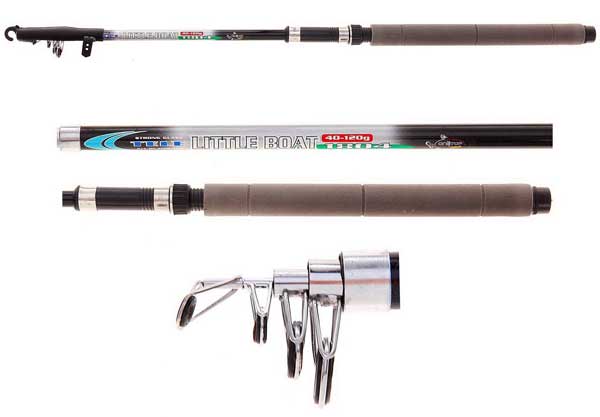
Rating of budget models

Shimano Exage Mini Telespin: a reliable and fairly light spinning rod with a length of 270 cm and a test that allows you to fish with both small baits weighing from 7 grams and heavier ones weighing up to 21 grams. The rod consists of 9 sections with guide rings located on high legs. The handle is detachable and made of lightweight cork. When folded, the rod is only 38 cm long and weighs 153 grams. For convenient carrying, the spinning rod comes with a hard short tube.
Shimano Catana Telespin - this Shimano telescopic spinning rod has become a real people's favorite over the years. A convenient 5-6 section rod with a solid cork handle, reliable guides with a length of 210 to 330 cm and a test weight of 10 to 30 grams allows you to catch both small and fairly large trophy fish in various conditions. The weight of such rods ranges from 120 to 180 grams, and the length when folded is up to 80 cm.
Norstream Voyager Telespin is a comfortable and lightweight spinning rod up to 300 cm long and weighing up to 170 grams. Allows you to fish with baits weighing from 5 to 25 grams. When folded, it takes up to 56 cm.
The best telescopic spinning rod models
These spinning rods include the following models, distinguished by their versatility and high quality:
- Shimano EXAGE BX STC MINI TELE SPINN (cost 3100-5100 rubles);
- Fantom Tele Spin (cost 2450-2890 rubles);
- Shimano EXAGE BX STC (cost 3400-3800 rubles);
- CATANA CX TELESPIN (cost 1600-2700 rubles).
Shimano
Today, Shimano, founded in 1921, is a leading manufacturer of fishing tackle. The favorite models of telescopic spinning rods among anglers include:
- Shimano CATANA CX TELESPIN 165UL (cost 2200-2500 rubles);
- Shimano TANA CX TELESPIN 330H (cost 2400-2800 rubles);
- Shimano EXAGE BX STC MINI TELE SPINN 180 L (cost 3100-3400 rubles);
- Shimano EXAGE BX STC MINI TELE SPINN (cost 31,000-5,100 rubles);
- Shimano EXAGE BX STC MINI TELE SPINN 165 L (cost 2800-3100 rubles).
Daiwa
High-quality models include:
- Megaforce Big Fish MFBF29TXH (cost 1800-2000 rubles);
- NEOVERSAL 565TLFS (cost 2600-2900 rubles);
- POWERMESH 2.70 (cost 2100-2200 rubles);
- SC-FA 48 UL (cost 5200-5500 rubles);
- SC-FA 510L (cost 5500-5700 rubles).
Kosadaka
Time-tested Kosadaka spinning rod models include:
- Kosadaka VOYAGER (prices range from $150 to $280);
- Kosadaka Blaze Tele (costs $50-$80);
- Kosadaka Voyager Tele (costs $40-$90).
Which spinning rod is better - plug-in or telescopic?
The answer to this question is individual and depends on many factors, but still, most fishermen, regardless of their skills, are inclined to use a two-armed rod. It is compact and reliable.
However, "telescopes" can also come in handy. Indeed, for some, compactness plays the most important role. In addition, this option is suitable as a backup. If you choose a telescopic spinning rod from leading brands, its quality may not be noticeable in comparison with plug-in rods. Recently, companies have been releasing fairly high-quality models that have excellent characteristics that delight even professionals.
